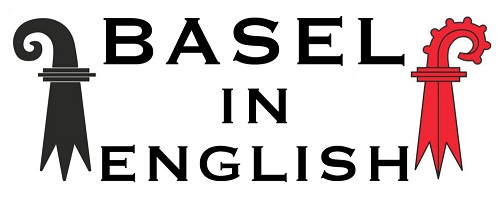The Carnival in Basel is Switzerland’s largest “carnival” and the main Protestant one in the world. However, its history has been lost in the mists of time as all the relevant records were lost in the devastating earthquake of 1356. The oldest document about the Carnival in Basel dates back to 1376.
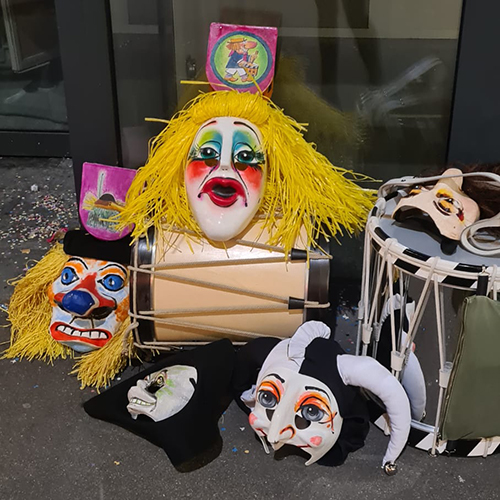
Like with most carnival customs, the roots of the Basel Fasnacht can be traced back to ancient Celtic and Germanic roots as well as practices relating to ancestor worship, fertility rites, and the expulsion of winter. Later on it was also influenced by events such as medieval jousts, military musters organised by the city’s guilds, and religious festivals before Lent. During the age of Reformation “merrymaking” and feasting were becoming increasingly restricted, even banned at times causing the Basel Fasnacht to gradually developed into a display of resistance against the city’s authorities.
In the 19th century, the nature of Fasnacht began to change. The first cliques were formed, Schnitzelbank singers made their appearance for the first time, and piccolos and drums gradually became the hallmark of Fasnacht. As time went on the parades became more political and gradually adopted their now typical satirical twist. Fasnacht as we know it today took shape in the latter half of the 20th century.
In the years, after the Second World War many new cliques were established, the quality of piccolos and drums rose to new levels. While the costumes and head-masks (Larve) took on their unique Basel touch. New traditions and rituals sprang up, many of which are still celebrated today as if they had existed already for centuries.
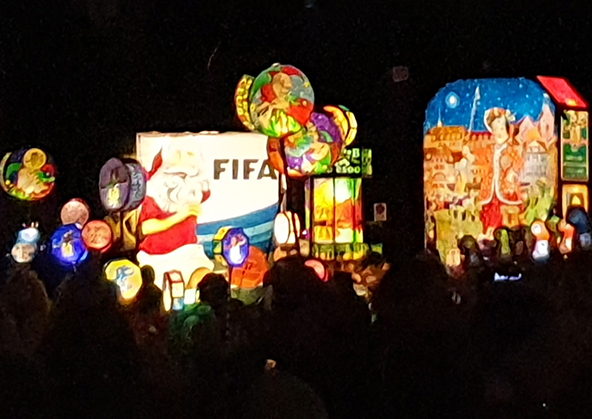
Guilds
Basel’s guilds had a considerable influence on the development of Fasnacht, “drey scheenschte Dääg” the loveliest three days.
In the 16th century the military was closely connected to Fasnacht requiring conscriptions of guild members to do military duty. Military elements were incorporated at that time which still characterise Fasnacht in Basel to this day: for example, the measured marching pace to the sound of drums and piccolos.
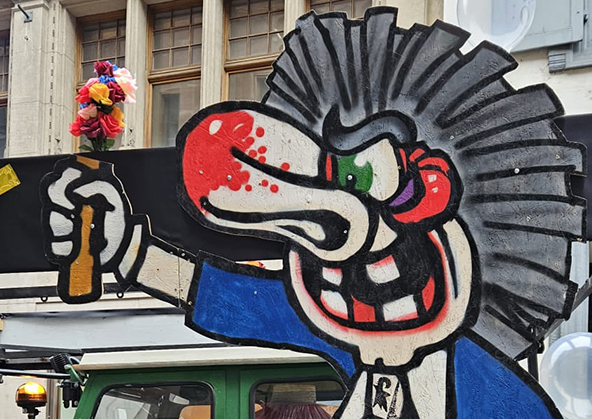 Blaggedde (Fasnacht badge)
Blaggedde (Fasnacht badge)
The “Blaggedde” is a brooch-like badge that features a new design every year, encapsulating the current motto of Fasnacht in Basel. It was introduced in 1911. The Fasnacht Committee (Comité) was permitted to sell them in order to finance part of the Fasnacht costs. The income still serves to subsidise the cliques.
The badge is available at the Tourist Information office from mid-January 2024 onwards.
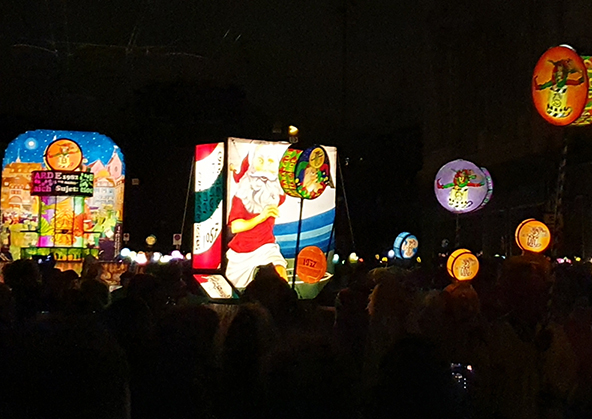 First Morgenstreich
First Morgenstreich
The first officially permitted Morgenstreich was held in 1835. Back then, the Fasnacht participants took to the alleys with burning torches.
The first pole-mounted lanterns appeared in 1845 when a ban on carrying open-flame torches was issued. The first large procession lantern was documented in 1860.
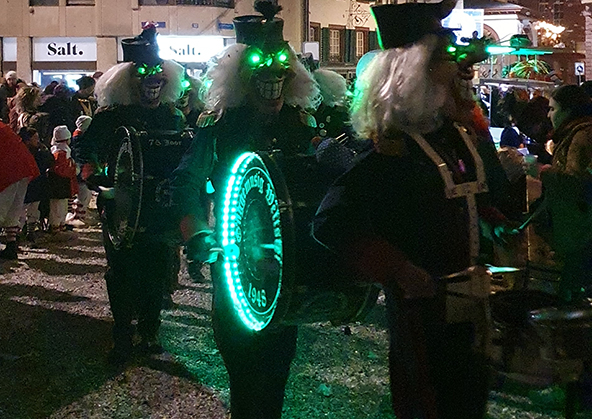 Committee
Committee
The Fasnacht Committee, founded in 1910, consists of ten to fifteen honorary members and is responsible for the organisation of the “drey scheenschte Dääg” loveliest three days of the year. It provides support to the groups involved in Fasnacht and mediates between the interests of the Fasnacht, the general public, and the authorities.
UNESCO Cultural Heritage
At its meeting on 7 December 2017 on Jeju Island (South Korea), the Intergovernmental Committee decided to include Basel’s Carnival in the Representative List of the Intangible Cultural Heritage of Humanity. The list comprises cultural forms of artistic expression such as dance, theatre and music, as well as oral heritage and traditions, and handicrafts. After the Winegrowers’ Festival in Vevey, the Basel Carnival is the second element of Swiss cultural heritage to be included in the list.
With its decision, UNESCO pays tribute to the rich tradition and singularity of this three-day event. What makes it so impressive, according to UNESCO, is its unique blend of music, written and oral forms of expression, and artisanal outputs.
And it’s not only local people who keep the tradition of the Carnival alive: every year, thousands of tourists come especially to Basel to be part of the festivities. Whether local or tourist, everyone is bowled over by the uniqueness, quality and sheer diversity of the event.
Traditional Carnival costumes
A large number of characters are on the move during Carnival (Fasnacht). Some of the “Goschdym” (costumes) are based on Italy’s Commedia dell’Arte, while others are inspired by local events.
At the Basel Fasnacht, active participants hide their true identity under a “Masgge” (full-body mask) according to the unwritten laws of Fasnacht. The head-mask is referred to as “Larve”.
Even today most of them are still elaborately handcrafted.
Many groups still design and create their own costumes and head-masks. The are primarily three types of costumes:
- Parade costumes (which tend to be inspired by current topics)
- Individual fantasy costumes
- Classical costumes
Some of the classical costumes have a long tradition, such as:
Harlequin
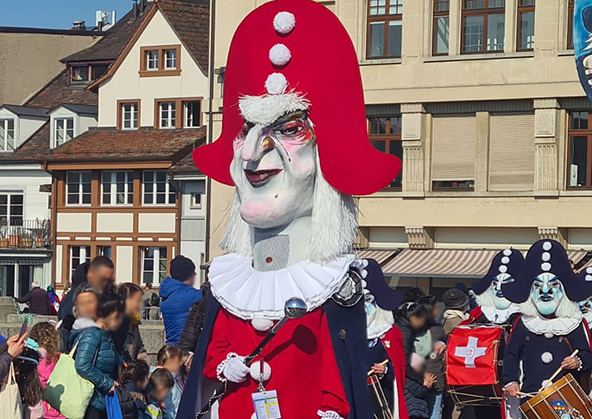 The carnival figure Harlequin (originally known as Arlecchino) is a servant character originating from Italy’s Commedia dell’arte. Harlequin wears a distinctive chequered costume and a cape, ruff, pompoms and harem pants.
The carnival figure Harlequin (originally known as Arlecchino) is a servant character originating from Italy’s Commedia dell’arte. Harlequin wears a distinctive chequered costume and a cape, ruff, pompoms and harem pants.
Waggis
 A caricature of an Alsatian peasant from the 19th century was the starting point of today’s “Waggis”. The people of Alsace used this name to denote a vagabond or day labourer. Even today, the character’s boisterous behaviour is just as much a part of this figure as his typical costume. However, the costume has undergone major changes over the years. For example the nose has grown steadily larger, and the clothes have taken on different colours.
A caricature of an Alsatian peasant from the 19th century was the starting point of today’s “Waggis”. The people of Alsace used this name to denote a vagabond or day labourer. Even today, the character’s boisterous behaviour is just as much a part of this figure as his typical costume. However, the costume has undergone major changes over the years. For example the nose has grown steadily larger, and the clothes have taken on different colours.
Dummpeter

The Dummpeter Fasnacht figure almost died out in the pre-war years. However, he is now often seen making an appearance again at Fasnacht. He has a childlike, dreamy expression and, because his mask features chubby cheeks, he lends himself to piccolo groups. However, his origins are not completely clear. According to one theory, his name was originally “Drummpeter” (trumpeter) but was modified to Dummpeter (literally “stupid Peter”) over the years.
Alti Dante

The figure of the “Alti Dante” (old dame) arose towards the end of the 19th century and was very popular in the early part of the 20th century. The Alti Dante is a caricature of a well-to-do older lady from Basel’s upper class. Her clothes and accessories are often reminiscent of the Biedermeier period.
Ueli
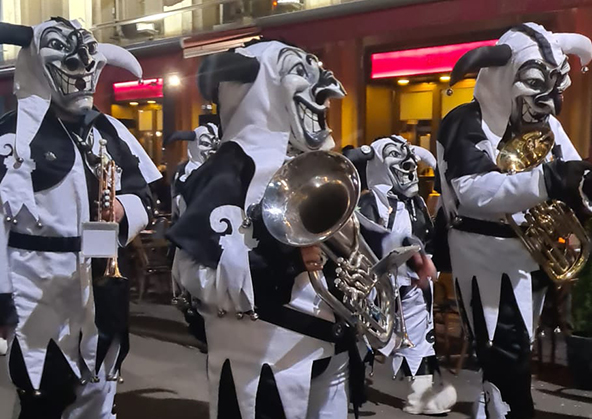
The Ueli harks back to the Mediaeval court jester, on whose outfit his costume is based. The top part and trousers are of two different colours, and he wears fabric horns on his head.
Another typical feature are the many bells attached to the costume. It’s therefore difficult not to hear a Carnival participant disguised as an Ueli.
Blätzlibajass
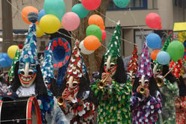
“Blätzlibajass” is a combination of the words “Blätzli” and “Bajass”. Bajass is the Basel dialect word for bajazzo, a clown in Italian Commedia dell’Arte. The term “Blätzli” refers to the hundreds or even thousands of pieces of fabric that adorn the costume.
Carnival participants
There are over 300 cliques, wagon cliques, carriages and Gugge music bands who register for the official procession each year. In addition, more than 200 lanterns are painted by hand for Fasnacht.
In Basel’s streets and alleys, over 100 Schnitzelbank performers plus countless individual figures and groups, who don’t participate in the procession, are on the move.
There are different ways of playing an active role in the Carnival:
Cliques
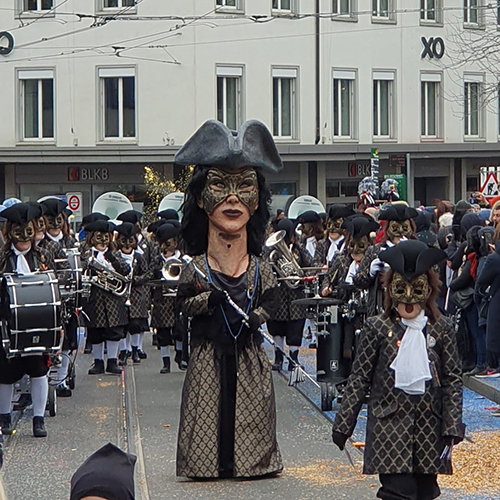
The first cliques were created around the middle of the 19th century from a number of Basel associations and societies. The first societies whose sole purpose was to participate in Carnival were set up around 1870. These often hailed from specific districts or suburbs, as reflected in some clique names such as Stainlemer, Spale or Glaibasler. During the loveliest three days, they march through the city centre with drums and piccolos and enhance the Carnival activity with both traditional marches and more modern music.
Gugge music

Brass instruments already began make an appearance around the mid-19th century. In the early part of the 20th century accordions and mandolin groups also took part in Fasnacht. Gugge music subsequently developed from the brass contingent. Around 70 groups of this type with over 2,000 active participants take part in the procession and give concerts, mainly on the tuesday evening. These are held in large squares but also in overcrowded pubs in the city centre.
Wagon cliques
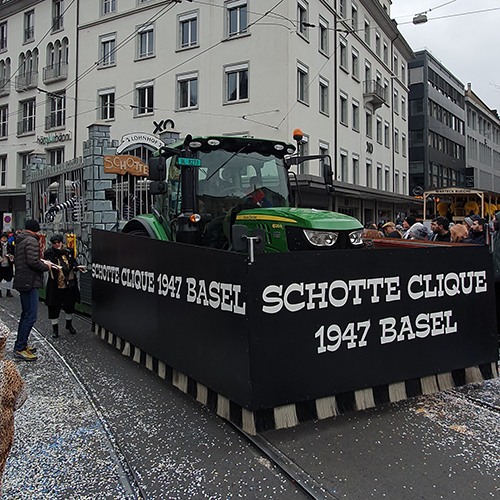
These cliques are a prominent feature of the two big “Cortège” parades. They present and act out themes on their elaborate and artistic vehicles. The Waggis on the floats distribute flowers and oranges along with other small treats – mostly food and drink – always coupled with a generous shower of confetti.
Schnitzelbank performers
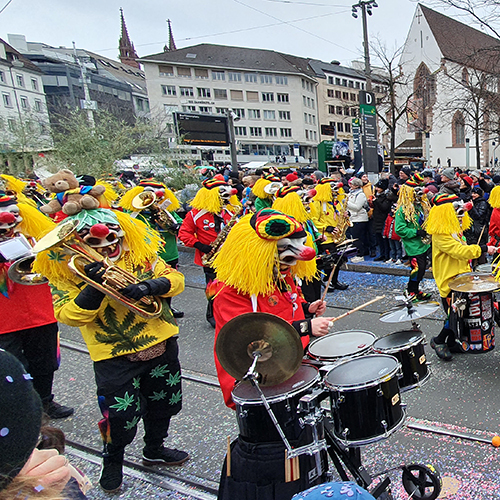
Schnitzelbank performers focus on topical events. Each verse deals with a different theme: events from the fields of politics, sport, economics and society that made the headlines during the past year. The verses are cleverly rhymed, humorous, and cutting or satirical. They hold the listeners’ attention right through to the laughter triggered by the punchline. The verse is usually accompanied by a musical instrument. The melodies are sometimes those of balladeers that have been handed down over generations, alternated with well-known folk tunes and modified versions of popular hits. The Schnitzelbank performers can be found mainly in pubs, restaurants and clique cellars.
— Adapted from the The history of the Carnival in Basel by Basel Tourismus.
